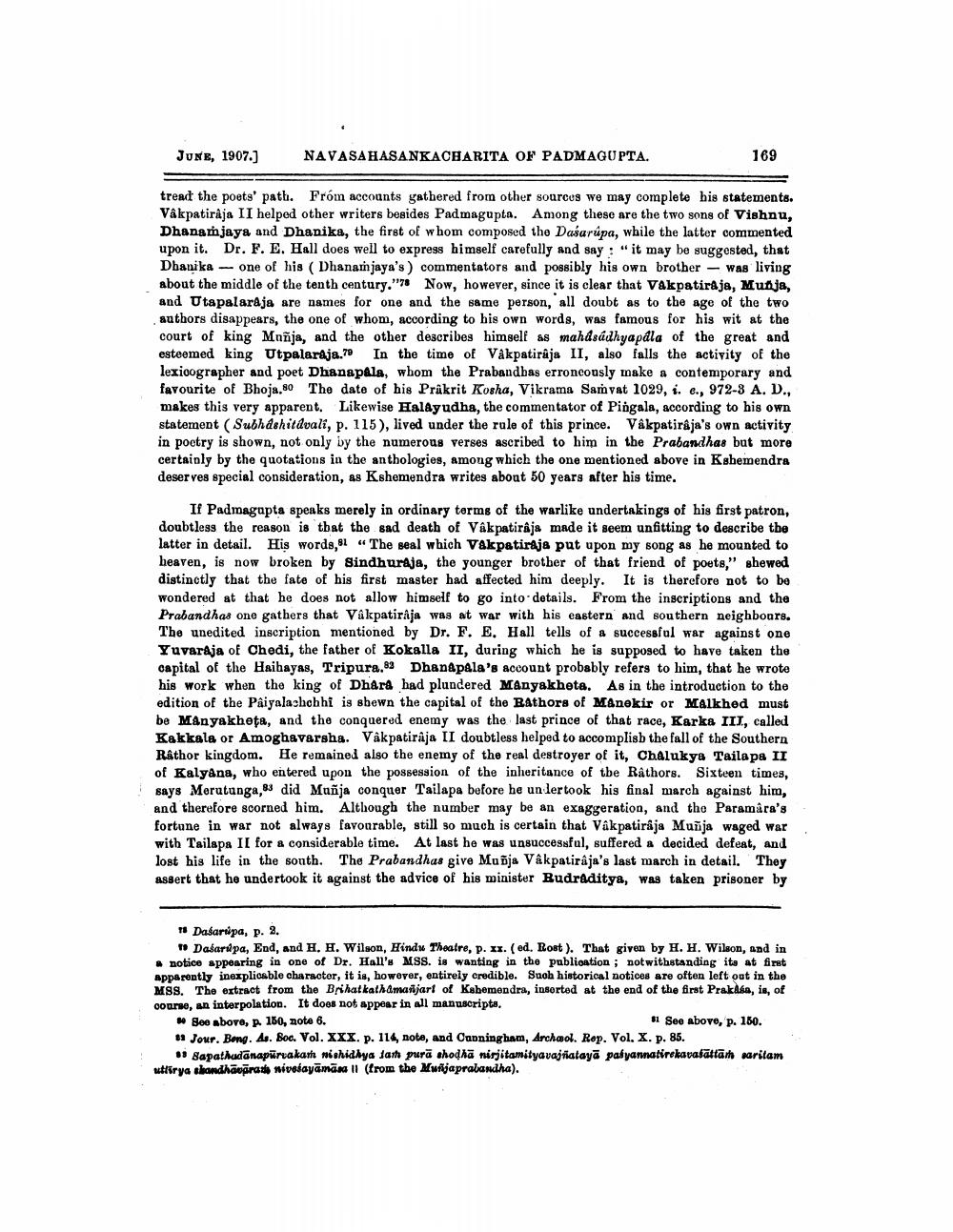________________
JUNE, 1907.)
NAVASAHASANKACHARITA OF PADMAGUPTA
169
tread the poets' path. From accounts gathered from other sources we may complete his statements. Vâkpatiraja II helped other writers besides Padmagupta. Among these are the two sons of Vishnu, Dhanamjaya and Dhanika, the first of whom composed the Dasarúpa, while the latter commented upon it. Dr. F. E. Hall does well to express himself carefully and say: "it may be suggested, that Dhanika - one of his ( Dhanamjaya's) commentators and possibly his own brother - was living about the middle of the tenth century."78 Now, however, since it is clear that Vakpatiraja, Munja, and Utapalaraja are names for one and the same person, all doubt as to the age of the two authors disappears, the one of whom, according to his own words, was famous for his wit at the court of king Moñja, and the other describes himself as mahdsádhyapdla of the great and esteemed king Utpalaraja.70 In the time of Våkpatirâja II, also falls the activity of the lexioographer and poet Dhanapala, whom the Prabandbas erroneously make a contemporary and favourite of Bhoja.so The date of his Prakrit Kosha, Vikrama Samvat 1029, i. 6., 972-3 A. D., makes this very apparent. Likewise Halayudha, the commentator of Pingala, according to his own statement (Subhdshitdvali, p. 115), lived under the rule of this prince. Våkpatirêja's own activity in poetry is shown, not only by the numerous verses ascribed to him in the Prabandhas but more certainly by the quotations in the anthologies, among which the one mentioned above in Kshemendra deserves special consideration, as Kshemendra writes about 50 years after his time.
If Padmagapta speaks merely in ordinary terms of the warlike undertakings of his first patron, doubtless the reason is that the sad death of Vakpatirâja made it seem unfitting to describe the latter in detail. His words, “The seal which VÅkpatiraje put upon my song as he mounted to heaven, is now broken by Sindhuraja, the younger brother of that friend of poets," shewed distinctly that the fate of his first master had affected him deeply. It is therefore not to be wondered at that he does not allow himself to go into details. From the inscriptions and the Prabandhas one gathers that Vakpatiraja was at war with his eastern and southern neighbours. The unedited inscription mentioned by Dr. F. E. Hall tells of a successful war against one Yuvaraja of Chedi, the father of Kokalla II, during which he is supposed to have taken the capital of the Haibayas, Tripura,82 Dhan pala's account probably refers to him, that he wrote his work when the king of Dhara had plundered Manyakheta. As in the introduction to the edition of the Pâiyalashchhi is shewn the capital of the Bathora of Manekir or Malkhed must be Manyakheta, and the conquered enemy was the last prince of that race, Karka III, called Kakkala or Amoghavarsha. Våkpatiraja II doubtless helped to accomplisb the fall of the Southern Ráthor kingdom. He remained also the enemy of the real destroyer of it, Chalukya Tailapa II of Kalyana, who entered upon the possession of the inheritance of the Rathors. Sixteen times, says Merutunga,83 did Muñja conquer Tailapa before he un lertook his final march against him, and therefore scorned him. Although the number may be an exaggeration, and the Paramara's fortune in war not always favourable, still so much is certain that Vakpatiraja Muñja waged war with Tailapa II for a considerable time. At last he was unsuccessful, suffered a decided defeat, and lost his life in the sonth. The Prabandhas give Muõja Vâkpatirâja's last march in detail. They Asgert that he undertook it against the advice of his minister Budraditya, was taken prisoner by
15 Dasarupa, p. 2.
** Dasarúpa, End, and H. H. Wilson, Hindu Theatre, p. II. (ed. Rost). That given by H. H. Wilson, and in # notice appearing in one of Dr. Hall's MSS. is wanting in the publication; notwithstanding its at first Apparently inexplicable character, it is, however, entirely credible. Suoh historical notices are often left out in the MSS. The extract from the Brihatkathamanjart of Ksbemendra, inserted at the end of the first Prakasa, is, of course, an interpolation. It does not appear in all manuscripts. * See above, p. 150, note 6.
1 See above, p. 150. Jour. Bong. A. Boc. Vol. XXX. p. 114, note, and Cunningham, Archeol. Rop. Vol. X. p. 85.
* Sapathudānapürakam nishidhya Jamh purā shodkā nirjitamityavajñatayā palyannatirekarafāttām saritam uttirya skandhävarade nivesayāmāsa Il (from the Mwijaprabandha).




